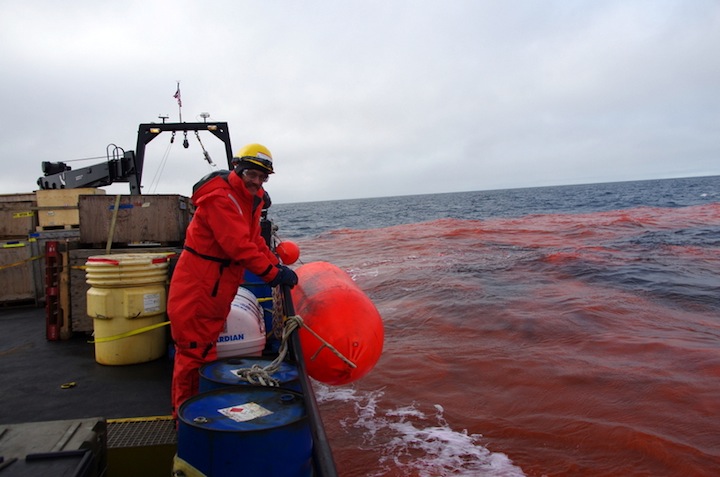Arctic Tracer Release Experiment (ARCTREX): Applications for Mapping Spilled Oil in Arctic Waters
ARCTREX preliminary science plan, 2015 cruise
Day 1 (Sept 5, 2014 - depending on weather): PreparationWe will board the Norseman II in Wainwright, AK via ship-to-ship transfer. We will unpack and install Acrobat system, CTD, gliders, microstructure instrument system, and assemble drifters and dye release equipment. For a separate project, a Sea Ice Detection Buoy will be deployed at the Chukchi Ecosystem Mooring site located at 71.59995 N, 161.5007 W. Then we will steam towards release site, which is ~75 nm due west of Wainwright in the Chukchi Sea. The through-flow system (thermosalinigraph) and shipboard ADCP will begin the survey of the study area while we transit.
Day 2: SurveyNext, we will survey the study area to prepare for the dye release. A glider will be deployed, and the shipboard ADCP data will be analysed to gain information about surface currents and direction. Pre-release surveys using the Acrobat and through-flow system will help characterize the stratification and T-S properties, and will determine the background levels of chlorophyll-a and other natural signals that might occur in the Rhodamine spectral peak. We will perform repeated microstructure profiles using the microstructure system. This is all designed to inform us where to release the dye in the water column and where we can expect the dye to go (i.e. where "downstream" is).
Day 2 or 3: Dye ReleaseThe first dye release will be near the bottom of the water column, below the pycnocline, at ~35 m depth, to simulate a well blow-out. On the ship, we will begin profiling with the VMP, perform towed Acrobat surveys, and determine the extent of dye patch (in 2D). The dye patch extent will be provided to NOAA ERMA. Because we expect the surface and bottom currents to be disconnected due to the high stratification, surface drifters will be less useful, though we may deploy some. We expect this plume to evolve slowly.
Day 4 to Day 5 or 6: Plume EvolutionWe will track the dye over time and space, with intermittent microstructure profiling. During this time, we will provide frequent updates to NOAA and the Coast Guard, and post daily "science blog" updates to BOEM.
Day 5 or 6: Second Dye ReleaseIf first dye release experiment is considered a success and “done”, and weather and cruise time allow, we will try to conduct a second release. The glider will be staying with dye release #1 and map that while we concentrate on release #2. This will most likely consist of a surface release in the middle of the mixed layer (~ 7 m depth). We will utilize drifters and the microstructure instrument system during this release too.
Day 6-8: CompletionWe will track the second dye release, and perform updates of its extent. The last day will be spent recovering the drifters and gliders, packing up, and transiting to Wainwright, where we will disembark via ship-to-shore transfer to Wainwright.
The information on this page is described in more detail in the Pre-Cruise Planning Report.

